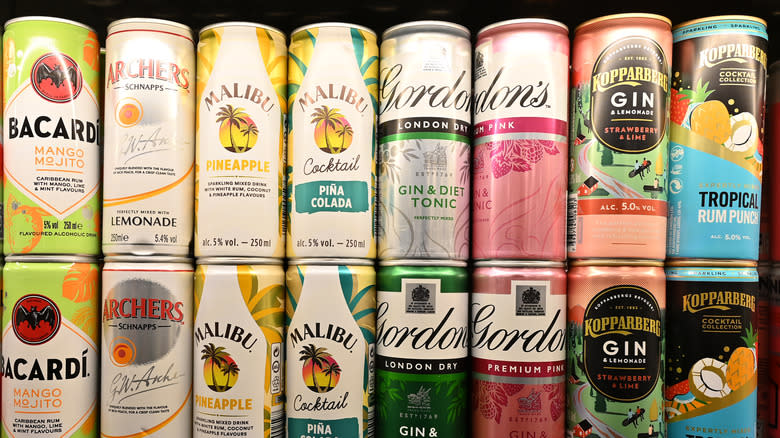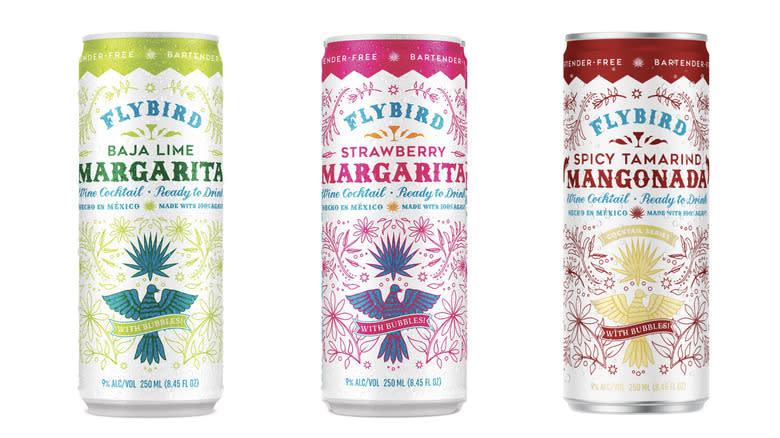Agave Wine Is The Key Ingredient Hidden In Many Canned Cocktails

It seems like yesterday that store-bought canned cocktails didn't even exist, much less did they exist in the realm of high-quality trendsetters. Now they're everywhere, from big-box stores to grocery chains, mom-and-pops, and even standalone liquor stores. However, the quality and versatility of today's ready-to-drink cocktails (RTDs) is undeniably superior to their predecessors, leading loads of folks to embrace the affordability and convenience of pop-top spirits. But there's more to the story; tucked within that exploding RTD industry is a subcultural sweetie known as wine-based cocktails.
Wine traditionally stands on its own exclusive merit, with little room for canned varieties. Not anymore, with the rampant rise of RTD wine-based cocktails, which are, by some accounts, considered the best-selling segment within the entire canned cocktail industry. But these aren't your usual wedding-fave mimosas, girlfriend rosé coolers, or pool-party sangria cocktails. There's a lesser-known secret to the success of canned wine cocktails, and it's called agave wine. In other words, many of these tasty grab-and-go wine cocktails aren't made with customary grape-based wine at all.
We all know agave as the smooth, suave, sweet ingredient in tequila, and it comes exclusively from the Weber Blue agave plant. It forms the base for classic cocktails such as the margarita, paloma, and tequila sunrise. Those drinks do exist in the new world of canned cocktails, but the kind of agave we're talking about here is different. In a wine-based RTD cocktail, the same Weber Blue agave plant works its magic -- but without distillation. Thus, the agave wine designation.
Read more: The 40 Absolute Best Cocktails That Feature Only 2 Ingredients
Agave Wine Sweetens The Deal In Canned Cocktails

Tequila and agave wine take the same path toward maturity, beginning with the piña heart of a Weber Blue agave plant, which is baked in earthen ovens in order to extract the sugars and juice, sometimes referred to as a syrup or honey water. It then ferments for at least three and up to 12 days. But here's where the two journeys veer in different directions.
While tequila heads into distillation, reaching adulthood at ABVs from 35% up to 55%, agave wine remains forever young. Its creators filter the fermented liquid and let it rest at average ABVs around 7.5%. This is a big draw for many who enjoy canned or bottled cocktails, as agave wine is lighter and contains less alcohol, making it more suitable for backyard BBQs or beachside sipping. Agave wine cocktails are uncomplicated low-ABV drinks, and they're more widely distributed and accessible, depending on alcohol laws per U.S. state.
However, there's such a thing as fortified agave wine, in which full-strength tequila gets added, sometimes doubling or even tripling the alcohol by volume. If it's genuine tequila made in Mexico added to the agave wine, you'll usually see a label such as "100% de Agave." Whether fortified or not, agave wine is extremely versatile in RTD cocktails, sometimes appearing in place of or accompanied by tequila in bottled or canned margaritas, but also in a wide range of other popular instant cocktails such as piña coladas and palomas.
Read the original article on Tasting Table


